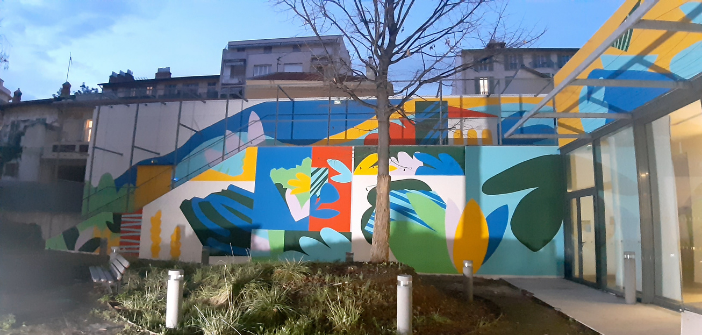The Claude Pompidou Institute in Nice has inaugurated a Street Art piece, created by Quebec artists Olivier Charland and Cécile Gariépy, for people with Alzheimer’s and their caregivers.
This initiative is in partnership with Mutualité Française PACA SSAM, France Alzheimer 06, the IA association, the Université Côte d’Azur, the CHU de Nice, COBTEK, Phenix Lab, and benefits from the support of the Conference of Funders, the CNSA, the Quebec Delegation in France, Mentia, and CrocosGoDigital.
Nice Premium met with Rémi Marcaillou, the Director of the EHPAD at the Institut Claude Pompidou, and Laure Chantepy, the art therapy project manager, who explained the project’s goal.
Rémi Marcaillou indicates that “the mural was created for all the users of the Institute (including staff members). There are residents, as it is a 100% Alzheimer’s Nursing Home. A day care center can accommodate up to 25 people per day. The Memory Resource and Research Center (CMRR) engages in screening and prevention, particularly in cognitive disorders and Alzheimer’s disease. The idea was to brighten up this place, which was sad, concrete-colored. It is a collaborative project, where everyone could participate (users, staff), in both intention and realization.”
Laure Chantepy specifies that “the artists captured an emotion, a desire, an expectation. They had to create a cheerful, soothing, colorful mural, with a local connotation that recalls nature.”
The Director of the Nursing Home adds that regarding the residents, the colors should not be too flashy or pastel, nor should there be any negative connotation.
Why turn to Quebec artists? “The partnership with a research lab has a strong connection with Quebec. This project started with a meeting with the Phenix Lab association. Participative street art originated in the United States. Olivier Dalban, president of Phenix Lab, went to Quebec to see what existed. He then established a collaboration with Quebec. Scientific exchanges also take place at the memory center.”
How long did it take to create this mural? “The artist arrived 10 days ago. He started outlining the shapes 8 days ago. The next day marked the beginning of painting. The creation project began in September. The artist was very nice. Coffee breaks are taken in this courtyard, so progress was slower than expected. It took longer than if he had done everything at once. The residents have a certain level of dependency, so it takes a lot of time. There was a desire for everyone to add their personal touch. Nursing home families and employees expressed what they wanted. The outlines were drawn, and residents painted the interior.”
Laure Chantepy explains that “the idea of this project was to break down stereotypes, to have a street art project in a nursing home, and to show that patients can paint sitting on the floor.” The painting was completed last Thursday.
“There is also an inclusive aspect. We welcome secondary schools, vocational high schools, and we conduct guided tours for schools to explain the disease and participative street art.” Last Thursday was the open house day. “There was a large crowd, with a choir, project presentations.” The institute wished to organize this open house the same day as the mural’s inauguration, which concluded the day. Partners and institutional representatives, such as the mayor’s office or the department, were present at the official evening inauguration.
Rémi Marcaillou is pleased with the project’s realization. “We talked about it, and now we will see the mural every day. It marks a first step in transforming this place.”
“We want to redesign the garden, making it suitable for the residents and users, and planted with flowers. It should become a refuge for urban fauna and flora. This new project will be developed by the end of May, beginning of June, in partnership with the Antibes horticultural high school. The institute’s vocation is this social link with the outside. It will be a new collaboration. It will be a place of stimulation through the senses: sight, smell, with specially chosen plants, and hearing, with birds. It’s very comprehensive. We will contact associations and partners for coherence in terms of plant materials. It must be eco-friendly, an urban garden requiring little water, reusing what we already have: plantings on the terrace, cuttings. Institute users will also participate in this project. The residents enjoy it, so it will still be carried out with them. There is always this educational side, with transmission. This garden must be a peaceful and suitable place.”
An animal mediator comes with different species of animals. “It soothes the residents, like music.” They enjoy it a lot. “These are the most suitable activities, allowing support for residents non-medically.”
The poles outside the Institute have even been decorated to recall the mural.


